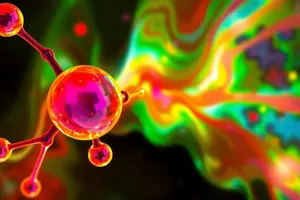Podcast
Questions and Answers
At what wavenumber does the broad O-H stretching band for alcohols typically appear?
At what wavenumber does the broad O-H stretching band for alcohols typically appear?
- 3400 cm−1
- 3200 cm−1
- 3800 cm−1
- 3600 cm−1 (correct)
What is the significance of the C=O stretching band in carbonyl compounds?
What is the significance of the C=O stretching band in carbonyl compounds?
- Is highly polar and produces strong absorption in IR spectrum (correct)
- Occurs between 2700 to 2800 cm-1 for aldehydes
- Is characteristic of alcohols and phenols
- Occurs at 900 to 690 cm-1
In which range do C=C stretching vibrations typically occur for aromatic rings?
In which range do C=C stretching vibrations typically occur for aromatic rings?
- 3000 cm-1 to 3100 cm-1
- 900 cm-1 to 690 cm-1
- 1475 cm-1 and 1600 cm-1 (correct)
- 3600 cm-1 to 3400 cm-1
What characteristic feature differentiates the O-H stretching band of phenols from that of alcohols?
What characteristic feature differentiates the O-H stretching band of phenols from that of alcohols?
Which type of compounds are characterized by a prominent band around 1710 - 1720 cm-1?
Which type of compounds are characterized by a prominent band around 1710 - 1720 cm-1?
Flashcards
Aromatic C-H Stretch
Aromatic C-H Stretch
The stretching vibration of the C-H bond in an aromatic ring. It typically appears between 3050 and 3010 cm-1 in an IR spectrum.
Aromatic C-H Out-of-Plane Bending
Aromatic C-H Out-of-Plane Bending
The bending vibration of the C-H bond that is out of the plane of the aromatic ring. It appears in the range of 900 to 690 cm-1 and helps identify the substitution pattern of the ring.
Carbonyl Stretch (C=O)
Carbonyl Stretch (C=O)
A strong and prominent peak in the IR spectrum around 1710-1720 cm-1, characteristic of the carbonyl group (C=O) present in aldehydes and ketones.
Aldehyde C-H Stretch
Aldehyde C-H Stretch
Signup and view all the flashcards
Alcohol O-H Stretch
Alcohol O-H Stretch
Signup and view all the flashcards
Study Notes
Infrared Spectroscopy (IR)
- IR spectroscopy analyzes the interaction of infrared radiation with molecules.
- Absorption of IR radiation causes molecular vibrations.
- Different functional groups absorb IR radiation at characteristic frequencies.
- This is used to identify functional groups in a molecule.
Aromatic Rings
- C-H stretch: 3050-3010 cm⁻¹
- C-H out-of-plane bending: 900-690 cm⁻¹
- C=C stretching: often appears in pairs at 1600 cm⁻¹ and 1475 cm⁻¹.
- The note specifies that this is helpful in determining the type of ring substitution (monosubstituted, ortho-substituted, meta-substituted, para-substituted).
Oxygen-Containing Compounds (Alcohols and Phenols)
- Alcohols and phenols exhibit characteristic infrared bands due to O-H and C-O stretching.
- O-H stretching is sensitive to hydrogen bonding.
- Alcohol O-H stretching is centered around 3600 cm⁻¹.
- Phenol O-H stretching is typically 50-100 cm⁻¹ lower than that of alcohols.
- The broad shape of the O-H stretching band makes it prominent in the spectrum.
- C-O stretching shows a strong band in the 1300-1000 cm⁻¹ region.
Carbonyl Compounds
- Carbonyl compounds contain a C=O functional group.
- This functional group is present in aldehydes, ketones, esters, amides, acid chlorides, and anhydrides.
- The C=O group strongly absorbs in the 1850-1650 cm⁻¹ range.
- Aldehydes and ketones show a strong, prominent, and characteristic "stake-shaped" band around 1710-1720 cm⁻¹.
- Aldehydes also show medium strength bands around 2700 and 2800 cm⁻¹ due to C-H bonds.
- These C-H bands are absent in ketones.
Studying That Suits You
Use AI to generate personalized quizzes and flashcards to suit your learning preferences.



